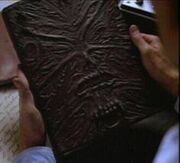![]()
![]()
![]()
![]() 🐙
Throughout its long history, the fictional Necronomicon has been translated and transcribed many times, giving rise to a number of distinct variants. This page aims to give a guide to these editions.
🐙
Throughout its long history, the fictional Necronomicon has been translated and transcribed many times, giving rise to a number of distinct variants. This page aims to give a guide to these editions.
Variants Originating From Lovecraft Circle Works[]
English "Dee" Translation[]
While staying at the home of a Baron Hauptman, the famed occultist Doctor John Dee made an English translation from Hauptman's Greek copy. (CIRCLE: "The Space-Eaters", HPL: "The Dunwich Horror"). Dee's translation is garbled and in many places he has changed outright the meaning of certain things to fit with in his own Enochian beliefs. Never the less, his translations of many of the spells remains accurate.
This version exists only in manuscript form; some fragments remain to this day, although it was never printed.(HPL: "History of the Necronomicon")
Greek Translation[]
In 950 AD Theodore Philétas of Constantinople made a Greek translation named the Necronomicon (HPL: "History of the Necronomicon") of the Kitab al Azif. This volume was named after its opening words. Despite a few errors, Philétas' reproductions of the book's charts and tables are faithful to Alhazred's original illustrations.
In 1050, the Patriarch Michael suppressed the book and had many of copies burnt. In 1232, it was again supressed by Pope Gregory IX (HPL: "History of the Necronomicon") and put on the Index Expurgatorius. (HPL: Selected Letters of H. P. Lovecraft 2.307)
Sometime between 1500 and 1550 in Italy, Philétas's Greek translation was printed (HPL: "History of the Necronomicon") or in 1567 (HPL: Letter to James Blish and William Miller, 13 May 1936) by the Italian Aldus Manutius, commissioning around one hundred folio sized copies.
In 1692, the last known copy was lost in a library fire in Salem and another was rumoured to be owned by Richard Upton Pickman who disappeard in 1926. (HPL: "History of the Necronomicon")
Interestingly, the Greek translation contains a spell not present in the original. It is a formula used to open a Gate under Memphis through which the black sphinx, one of the million favoured ones, may enter the world. It is unknown whether Philétas added this spell of his own accord or if it had been added to his Arabic version by a previous owner (source?).
Latin Translation[]
A Latin translation of Philétas's Greek version was made in 1228 by a Dominican monk named Olaus Wormius (HPL: "The Festival", "History of the Necronomicon"), no relation to the 16th century Danish physician Ole Worm.
Its prefatory note indicate that the original Arabian text was considered lost. (HPL: "History of the Necronomicon")
Unfortunately Wormius' beautifully stylised illustrations robbed many of the star charts of their accuracy.
In 1232, this edition was outlawed by Pope Gregory IX, (HPL: "History of the Necronomicon") and put on the Index Expurgatorius, (HPL: Selected Letters of H. P. Lovecraft 2.307), after which many copies were destroyed, although it was widely printed until then.
In the 15th century, the Latin translation was printed with black-letters by an uncredited German publisher (HPL: "History of the Necronomicon") in 1477. A number of woodcuts were added.
In the 17th century, another uncredited print was made in Spanish (HPL: "History of the Necronomicon") in 1623 (HPL: Letter to James Blish and William Miller, 13 May 1936) or 1662. Both this and the above version were 802-page long folios.
There is one known remaining copy of the German edition locked in the British Museum, and one supposedly owned by an American millionaire. (HPL: "History of the Necronomicon")
Four copies are known of the Spanish edition, in the Bibliothèque Nationale in France, Widener Library in Harvard, Miskatonic University, and Buenos Aires' university. (HPL: "History of the Necronomicon")
Other secret ones exist: one at a Londonian book-seller, one at Kingsport (HPL: "The Descendant", "The Dunwich Horror").
Kitab al-Azif[]
The Al Azif, (HPL: "History of the Necronomicon") also known as the Kitab al-Azif, is the Arabic manuscript, faithful to Abdul Alhazred's original. These version are written upon scrolls and preserved in codices. All in all its contents total over one thousand pages complete with star charts, formula tables and astrological maps.
The original manuscript was written circa 730 AD in Damascus, and by 1228 AD was considered lost. (HPL: "History of the Necronomicon")
The original, smelling like corpse, eventually went to sorcerers siblings. (CIRCLE: The Return of the Sorcerer Clark Ashton Smith])
Its name section "azif" is the sound of insects and daemons. (ADJ: Vathek [note by Henley], HPL: "History of the Necronomicon", Selected Letters 2.307)
Variants Originating From Expanded Mythos Works[]
Feery's Notes on the Necronomicon[]
In 1901 the noted occultist Joachim Feery produced a pamphlet on the book. It is mostly made up of translated quotes from the Latin version, augmented by pages of notes and speculation on their meaning. The accuracy of this publication was called into question when Feery freely admitted including excerpts from his own dreams.
Francesci's Cult of the Necronomicon[]
Created by a man named Giorgio Francesci from a combination of passages from Feery's Notes on the Necronomicon and an unknown translation from the British Museum, this version first saw print as a supposed promotional script for a movie. In reality, the occult contents cast a kind of glamour over those who read it, and the film which was created resulted in widespread insanity and the return of the Old Ones. At least one copy of Francesci's Cult survived the apocalypse in the hands of a man named Stanley Pickman (EXP: The Bh'Yhlun series, Ian Davey).
Hali's Booke[]
According to one account, the Necronomicon is Lovecraft's literary equivalent to the Kitab al Hikmah al Najmiyya written in 703 AD by Khālid Ibn Yazīd, also known as Calid or Hali. (EXP: Providence)
In 1203, Ahmad Ibn 'Ali Ibn Yusuf Al-Buni anonymously writes an expended revision from a copy of the Kitab. (EXP: Providence)
Circa 1250, in Toledo, Al-Buni's revision is translated into Latin as Liber Stella Sapiente, supposedly ordered by Alfonso the Wise. In 1498, less than 50 copies of the Liber Stella Sapiente are published in Venice by Aldus Manutius. Jacques Roulet allegedly came in contact with one copy. By 1919, two known copies remain in Europe and one in Asia Minor. One copy was in St John's chappel for the inner head of the Worshipful Order of the Stella Sapiente. (EXP: Providence)
In 1651, the book is translated into English as Hali's Booke of the Wisdom of the Star by Robert Turner, also known as Philo-Mathes, printed in London by J.C. for and sold at N. Brook's the Angel shop in Cornhill and J. Harrison's the Holy Lamb shop east of St Paul's Cathedral. It contains a credit frontiscpice. It was put on the Index Liber Prohibitum. In 1686, a copy was brought by Etienne Roulet to America and given to St Anselm's College in 1889 once his Stella Sapiente Order found other editions. In 1904, Garland Wheatlet gives a transcript of Hali's Booke to Robert Suydam through Tobit Boggs. In 1905, Suydam gives a transcript to Dr Emilio Alvarez and Dr Estes. (EXP: Providence)
It 1887, this version inspired Sous le Monde by Claude Guillot and in 1895, inspired The King in Yellow by Robert Chambers. (HPL: "History of the Necronomicon", EXP: Providence)
The Sussex Manuscript[]
- Main article: The Sussex Manuscript
Baron Frederic of Sussex produced a supposed translation in illuminated manuscript form. This translation is rife with inaccuracies and fanciful ideas added by the author. It contains such outlandish misconceptions as Cthulhu being a manifestation of Nyarlathotep, and Abhoth having created the solar system. Although this "translation" is commonly called The Sussex Manuscript its proper title is Cultus Maleficarum.
Das Verichteraraberbuch[]
Friedrich von Junzt made a translation into German from an unknown Greek copy. This translation was published in Ingolstadt eight years after his death 1840 but are few further details (EXP: "Schrödinger's Cat Trilogy", Robert Anton Wilson).
Voynich Manuscript[]
A secret encrypted Arabian copy of the Necronomicon. (EXP: "Return of the Lloigor", Colin Wilson)
This version is inspired by the real-world Voynich Manuscript, a text likely dating from the 1400s whose exact nature has been a cause for much debate [1].
Al Azif Ex Mortis[]
In the Demonbane series by Nitroplus, Al Azif Ex Mortis was a copy of the original Necronomicon (aka Al Azif), who takes the form of a human girl and embodies all the alternate Al Azifs that failed their mission throughout the infinite multiverse. Due to her being the creation of Yoguruma Mugen (an avatar of Yog-Sothoth), she is virtually omnipotent in terms of power, having unlimited access and influence over countless universes. Al Azif Ex Mortis is eventually defeated and absorbed by the original Al Azif. (EXP: Nitroplus Blasterz: Heroines Infinite Duel)
Variants Originating From Mythos-Inspired Works[]
Archon Necronomicon[]
Also known as the Book of Dead Names it was older than Gallifrey and most other solar systems. It spoke of the time before time, of the Old Ones, with the memories of the Archons who ruled the galaxy. The text on the leather cover is close to Sumerian, Vedic Script and Rongorongo but older.
The ancient race known as the Archons gave it to the Master so that he would carry out their plans. The Master gave the book to the Second Doctor's companion, Jamie McCrimmon, who then passed it on to the Doctor. When the Doctor touched the book, it activated and piloted the Doctor's TARDIS to the Nameless City of the Archon in the Great Desolation outside of space. (ADJ: "The Nameless City", Doctor Who) Archons fought Ancients and Earthlord in their Nameless Metropolis (ADJ: The Secrets Of The Immortal Nicholas Flamel).
Eocene Necronomicon[]
Named after the ancient language in which it was written this version only existed in fragments by the early 20th century. Original illustrations accompanying the book were done by a man named Roerich, though matching images can be found in stone carvings on Earth, Veltroch, Exo Three, and many other planets. The illustrations depict the Great Old Ones, which the text refers to as the Great Ones, walling their bodies into stone citadels. (ADJ: White Darkness, Doctor Who)
Lovecraft's Necronomicon[]
According to the Eighth Doctor, the Necronomicon was a fictional creation by H. P. Lovecraft and by the 26th century, he estimated there were no less than seventy-nine different fake Necronomicons.
Compassion, while acutely affected by a fictional generator which drew her into its narrative, authoritatively claimed that gothic writers often included excerpts of the Necronomicon in their novels, with little understanding of their context. This recklessness helped paint alien races like the Elder Things as monsters. (ADJ: The Taking of Planet 5, Doctor Who)
Necronomicon Ex-Mortis[]

The Necronomicon Ex-Mortis
The Necronomicon Ex-Mortis is described as being "bound in flesh, and writ in human blood" and has a mutilated face as the cover. It is written in ancient Sumerian and contains many spells, some linked to Kandarian cults. (ADJ: The Evil Dead series ).
Following the release of the Evil Dead movies, the Necronomicon has frequently been described as being bound in human skin, as in Stuart Gordon's TV adaptation of "The Dreams in the Witch-House".
Spanish Translation[]
The Necronomicon was translated into Spanish, supposedly in AD 1600 from the original Arabic. (ADJ: The Banquo Legacy, Doctor Who)
References[]
- ↑ The Voynich manuscript at Wikipedia

